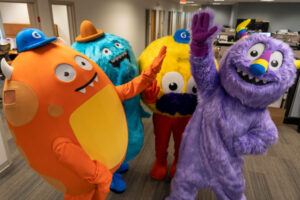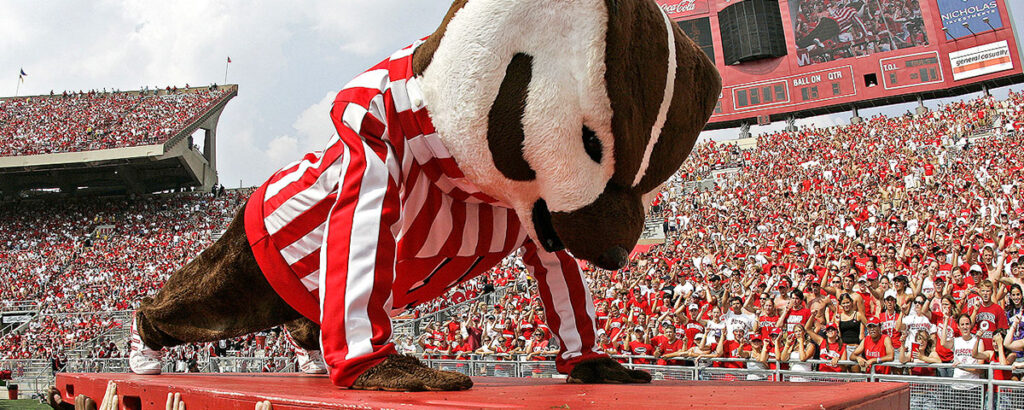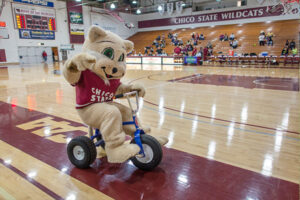How to Perform in Your Mascot Costume [Video Transcription]
“Welcome to Mascotting 101!
Becoming a mascot is tough work and requires practice. Luckily, we have Ollie, the beloved Olympus mascot to help us out. With his help, this video will give you all the tools you need to be successful as a mascot. Let’s learn how to be a mascot!
Performing as a mascot is both physically and mentally demanding. You have to maintain constant motion; entertain and interact with fans, children, and other mascots; be funny and spontaneous; all the while trying to give your character a lovable personality. It’s also fun, rewarding, and if done well, valuable to your team, company, or brand.
Mascots are incredible marketing tools. Therefore, it’s important that performers have the knowledge and ability to make a successful mascot both in and out of the mascot suit. Pay close attention to Ollie’s instructions and you will learn everything you need to know about the ups and downs and the do’s and don’ts on how to be a mascot performer.
Let’s get started!
Mascot Performer Preparation: Section One
Before you perform as a mascot, it’s important that you are knowledgeable about the mascot suit itself. Each mascot suit is unique, so you will need to practice getting in and out of your specific suit. In some cases, you may need a handler to help with certain pieces. Although, getting ready starts even before you put on the first piece of the mascot costume.
Mascot performers will want to stay cool under the costume. Here are the suggested clothing items to wear under a mascot costume. As a performer, you should always be wearing a shirt, shorts, and socks. Some mascots have costume feet or shoes, but tennis shoes may be worn as well. In order to keep sweat out of your eyes, it is always recommended that you wear some kind of bandanna or headband. Other items you may want to bring to your performance may include a towel, water bottle, or anything else that might help you cool off when you get out of the suit.
Getting in and out of the mascot costume suit will become easier with practice. The more events that you perform at, the quicker this process will become. However, even the most experienced mascots still have to deal with mascot costume malfunctions.
Mascot Costume Malfunctions: Section Two
Mascot costume malfunctions are inevitable, but here are some tips and info about what to do when something goes wrong with your mascot suit.
To lower the chances of a malfunction, you should check in a mirror to see how the costume looks before you perform. This will give you time to do some last-minute grooming to make sure your mascot is looking their best.
Now, let’s look at some of the most common mascot costume malfunctions. Malfunctions are unique to each mascot. They can range from an untucked strap to exposed skin to your mascot’s head falling off. These malfunctions can ruin the magic of your character for children and can be very frightening for others. So, while you should do your best to avoid them, malfunctions will happen. In the case of a malfunction, either go to a private area to fix it yourself, or have your helper come and fix it for you. Under no circumstances, remove a piece of the costume in front of the public. Once you are all fixed, you can head back out.
Mascot Performing Basics: Section Three
Now that you know how to properly get into the suit and what to do in the case of a malfunction, let’s start learning how to perform as your mascot.
Emotions are the best way to show animation and act out your moves. Here are some basic emotions you can use when performing:
- Happy– any upbeat and kind gesture can work for the emotion of happy.
- Sadness– Slumping your head and shoulders while wiping a tear away is one of the best ways to show sadness. This emotion can transition very well into a sad walk.
- Stressed- putting both hands on the side of the head and shaking it back and forth is an easy way to look stressed as a mascot.
- Shyness– a timid emotion while initially looking away is the best way to show shyness. This emotion is very valuable and can help a scared child be less afraid of a mascot.
- Suave– running your hands through your fur is a great way to make your mascot look suave. With all the emotions, especially acting suave, it’s important that you use it at appropriate times.
- Exhausted– after long events, you’ll be very exhausted. Use this emotion to show either kids or your helper that you’re tired. This could also be used as a signal that you need to take a break.
- Head Tilt- you can achieve many emotions, like curiosity, with a simple tilt of the head. The angle that you tilt the head helps determine exactly what emotion you’re trying to display. For example, disappointment is a different kind of head tilt.
Other powerful tools for mascot performers are gestures. Let’s go over the essential gestures that you’ll need to know as a mascot.
- Welcome and Hello– this is the most common gesture your mascot will do. Waving or gesturing ‘Come In!’ is the best way to welcome guests as they come through the door.
- Goodbye– goodbyes are sad. You can incorporate the sad emotion to say a mellow goodbye to guests who are leaving.
- Blowing Kisses– with this gesture, make sure you’re selling the motion. Blowing kisses is a great gesture, as long as it is done at appropriate times.
- Chivalry– like a tip of the cap, is a respectful way to acknowledge authority figures or women as a mascot.
- Playful Mocking– be careful who you do this gesture to. It’s important that your mascot does this to be funny, not rude.
Basic emotions and gestures can easily be learned with a little bit of practice. When you get more comfortable performing as your mascot, they’ll become like second nature. When you’re performing, keep trying these and other emotions so you can improve your mascot and skills.
Mascot Performer Do’s and Don’ts: Section Four
Now that you’ve learned the main mascot movements, let’s go over the essential do’s and don’ts of being a mascot.
Mascot Performer Do’s:
- Always be in character. When you put on your mascot suit, you should instantly take on your mascot’s character. When you’re performing, there is always someone watching, so it is important to be playful, animated, and enthusiastic as a mascot performer.
- Constant motion is a must. You are an entertainer. It is important that you are always moving and going from one place to another. However, remember to always keep a constant walk when going from one place to the next.
- Have fun! Being a mascot is a large responsibility and hard work, but that doesn’t mean you can’t enjoy yourself while performing. If you are having fun as a mascot, it will make the character genuinely look like they’re having fun too.
While it’s important that you follow these essential mascot performing do’s, it’s just as important that you never do any of these don’ts.
Mascot Performer Don’ts:
- Never speak! This is the number one rule of mascotting. Unless it’s an absolute emergency, you should never talk while in costume. If an emergency arises and you need to talk, make sure you do so in a private room. Otherwise, learn to use your emotions and creativity while performing.
- Don’t pick up kids. This can be very dangerous. Kids of all ages can be squirming, and there’s a chance you could drop them. Some parents may absolutely insist on you holding their kids. If this happens, either get down on one knee or sit all the way down.
- Don’t change in public. Seeing a mascot without a head can be very traumatic for kids. If you need to remove any part of your costume, make sure you do it in a private area.
PS: Want more mascot performer do’s and don’ts? Check out this blog.
Three T’s of Children: Section Five
One of the most important things you must learn as a mascot is how to approach different types of children.
The first ‘T’ stands for ‘Terrific Children’. These children love mascots. They’re excited, and they treat you with respect. Often time, these children range from four to ten years old. Follow all the basic rules and guidelines for performing and these children will continue to be your biggest fans.
The second ‘T’ stands for ‘Terrified Children’. These are the children who may scream, cry, or run away when they see mascots. Most of the time, these children are younger in age. In order to deal with these kinds of children, you must follow these steps:
- Mark your distance. Take one or many steps back to calm the child.
- Drop your level. Mascots are tall, so it’s important to get down on a knee or to completely sit down so you’re less intimidating.
- Play games. Waving or playing ‘peek-a-boo’ can be helpful tools when trying to win over a terrified child.
- Look away. Often times, children will be scared if a mascot keeps staring at them. Looking away can help you seem less creepy.
- Keep smiling. This means you need to maintain a positive body attitude and posture.
- Offer your hand. Children may be more accepting if they realize you are soft and friendly.
- Interact with parents. High fiving or hugging parents can make a terrified child realize that a mascot is nice, not scary.
- Walk away. Some kids may never get over their fear of mascots. If you’ve tried the other steps without any success, then it’s simply time to leave the child alone.
The third ‘T’ stands for ‘Terrifying Children. These are the children that want to chase, taunt, poke, hit, and with mascots. Typically, terrifying children are a bit older. Similar to the terrified children, you should deal with terrifying children by following a set of steps:
- Calmly diffuse. Be playful and try to get the child to divert their attention from harassing you to interacting with you.
- Give the ‘hearty handshake’. This is a handshake where you should apply enough pressure to let the kid know that they should stop, but not too much pressure to cause any harm.
- If a child still won’t stop, it’s time to signal for help. Let your helper intervene to distract the child.
Simply walk away. Interacting with children can be one of the toughest parts of being a mascot, but it can also be the most rewarding and fun. You’ll encounter all three types of children, but always be sure to follow these steps and tips.
Mascot Props & Skits: Section Six
In the last section, we are going to talk about two tools, that if used correctly can help any mascot portray humor.
Prop usage can be spontaneous, or it can be pre-planned. Using a prop in a manner other than intended is one of the best ways to get a laugh.
Prop usage also works very well in skits. Unlike random prop usage, skits need to be pre-planned. Your handler, your skit participants, and your organization needs to be aware of what the skit will entail before you perform. The best way to achieve this is to schedule a meeting prior to performing the skit.
As long as everyone is on the same page about skits, they can be extremely successful tools for any mascot to use.
In summary, this video has covered the preparation; items necessary to perform; costume malfunctions; performing basics; essential do’s and don’ts; the three ‘T’s’ of children; and how to incorporate props and skits. Remember, being a mascot is an important responsibility, but you also need to have fun. Practice makes perfect!”



